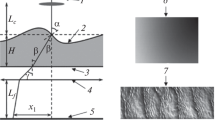Abstract
An investigation of the drift velocity induced by water waves of a contminated surface layer is carried out. The theoretical analysis is based on a thin boundary layer on the free surface. The results of the analysis reveal that the drift velocity of a viscous layer on the water surface is 7/4 times the Stokes prediction ofc(ak) 2 wherec is the wave celerity andak the wave slope. The present experimental investigation confirms the validity of the theoretical prediction for the drift velocity for a lightly contaminated surface layer; however, for a heavily contaminated surface layer, the experimental results exceed the theoretical prediction. An investigation for a heavily contaminated layer is carried out assuming an inextensible surface layer. Thus, in the experiment, vinyl sheets are used to substitute the contaminated layers. By balancing the wave-induced mean thrust force with the mean drag force, the drift velocity is obtained and compared with the experimental results. Based on the theoretical and experimental analyses, formulae for predicting the drift velocities for laminar and turbulent flow conditions are proposed.
Similar content being viewed by others
References
Stokes GG (1847) On the theory of oscillatory waves. Trans Cambridge Philos Soc 8:441–455
Longuet-Higgins MS (1953) Mass transport in water waves. Philos Trans R Soc London, Series A 245:535–581
Longuet-Higgins MS (1960) Mass transport in the boundary layer at a free oscillating surface. J Fluid Mech 8:293–306
Dore BD (1972) A study of mass transport in boundary layer at oscillating free-surfaces and interfaces. Proceedings of the IUTAM Symposium on Unsteady Boundary Layer, vol 2. University of Laval Press, pp 1538–1583
Dore BD (1974) The mass transport velocity due to interacting wave trains. Meccanica 9:172–178
Phillips OM (1977) The Dynamics of the Upper Ocean, 2nd edn. Cambridge University Press, pp 45–58
Huang NE (1970) Mass transport induced by wave motion. J Mar Res 28:35–50
Ünlüata U, Mei CC (1970) Mass transport in water waves. J Geophys Res 75:7611–7618
Kamata M (1982) Oil Slick Behavior in Waves. Ph.D. Thesis, Rice University, Houston, Texas, U.S.A., pp 23–40
Teeson D, White FM, Schenck H (1970) Studies of the simulation of drifting oil by polyethylene sheets. Ocean Eng 2:1–11
Alofs DJ, Reisbig RL (1972) An experimental evaluation of oil slick movement caused by waves. J Phys Oceanogr 2:439–443
Davies JT, Rideal EK (1963) Interfacial Phenomena, 2nd edn. Academic, New York, pp 42–47
Coleman HW, Steele WG Jr (1989) Experimentation and Uncertainty Analysis for Engineers. Wiley, New York, pp 17–39
Author information
Authors and Affiliations
About this article
Cite this article
Kang, K.H., Lee, C.M. Steady streaming of viscous surface layer in waves. J Mar Sci Technol 1, 3–12 (1995). https://doi.org/10.1007/BF01240008
Received:
Accepted:
Issue Date:
DOI: https://doi.org/10.1007/BF01240008




